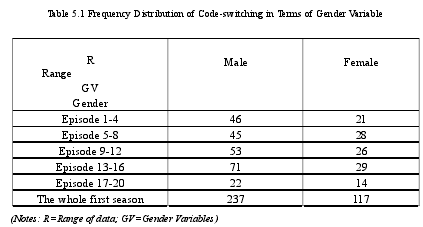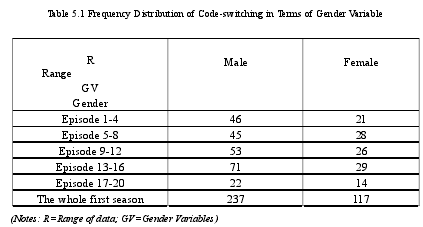CHAPTER I INTRODUCTION
1.1 Research Background
Human beings can communicate fluently with the help of language. Code-switching is the phenomenon which employs two or even more languages or language variations at the same time in a dialogue or conversation. Along with the increasingly closer and more frequent international communication, this phenomenon has a strong impact on daily life.
Code-switching is the product of linguistic communication and language contact of different ethnic groups through a long period. It refers to the alternate use of two or more languages and language varieties in the same conversation. This phenomenon has received wide attentions from many different academic fields, such as sociolinguistics and pragmatics. Since 1970s it has been studied by researchers from many approaches including sociolinguistic approach, psycholinguistic approach, grammatical approach, conversational approach and pragmatic approach. As one of the important results of language contact, code-switching indicates that speakers are mostly bilingual or multilingual and are capable of using two and even more languages alternatively in daily communication. Nowadays code-switching has been employed in daily conversations, newspapers commercials and even sitcoms. This study will take the sitcom Ipartment as an example to analyze the phenomenon of code-switching.
.....................
1.2 Aims and Significance of the Study
What’s more this study aims to identify how the social variables including gender and social class scientifically and statistically affect the use of code-switching with data analysis. Code-switching as a linguistic phenomenon in this sitcom is a tactics for communication.
Moreover, it is rare to connect the sociolinguistic variables especially gender and social class with the adaptation of code-switching. Under the theories of Verschuren’s adaptation theory (2000), this research will investigate adaptation of each code-switching between two groups: males and females, as well as the higher social class and the lower social class.
In conclusion, this study will make it more clear about the differences in the use of code-switching between different genders and different social classes. It will be of great value to understand the essence of code-switching, help the audience comprehend the phenomenon of code-switching from the perspective of gender variable and social class variable, and make Ipartment more popular than before. The audience’s attitudes are also investigated in this study.
.....................
CHAPTER II LITERATURE REVIEW
2.1 Introduction
Generally speaking, there isn’t a stable definition of code-switching although different scholars have put forward many definitions to define this phenomenon. People from different areas or countries all over the world use all kinds of languages and dialects. The great development of globalization makes it possible for people to interact and cooperate by learning other languages. Therefore, code-switching is the natural and unavoidable result of frequent language communication. As the hot research topic, code-switching has been studied from various fields such as linguistics, sociology, and ethnography. Scholars have studied code-switching form five approaches including sociolinguistics approach, psycholinguistic approach, grammatical approach, conversational approach, and pragmatic approach.
The main task of this chapter is to present a general literature review of the relevant studies about code-switching. There are four sections in this chapter. Firstly, the definitions of code-switching are given and different types of code-switching are shown. Secondly, five approaches to investigate code-switching are presented one by one including the sociolinguistics approach, psycholinguistic approach, grammatical approach, conversational approach, and pragmatic approach. At last the previous studies of code-switching in the sitcom Ipartment are mentioned.
........................
2.2 Review on Approaches to the Study of Code-switching
Since 1970s the phenomenon of code-switching is mainly studied from the following approaches: the sociolinguistic approach, the psycholinguistic approach, the grammatical approach, the conversational analysis approach and the pragmatic approach. Rich literature and works have been accomplished with the help of great contribution of researchers.
Gumperz (1982) concludes six conversational code-switching including quotation, addressee specification, interjection, reiteration message qualification personalization and objectivization. Research on code-switching of English and Spanish in Gibraltar area is a typical sociolinguistic approach because the locals use code-switching to protect their unique identity when Spanish government continues to claim their ownership of this area (Yu, 2000). Myers-Scotton invents markedness model to prove that there are unmarked choice and marked choice in code-switching.
Sociolinguistic approach explores the relationship between code-switching and social variables such as the relationship of code-switching and ethnic identity. Researchers find that this approach can not show the active process of code-switching, letting alone explain the role of cognition and mental activities.
............................
CHAPTER III THEORETICAL FRAMEWORK OF THE STUDY ...... 24
3.1 Verschueren’s Linguistic Adaptation Theory ............... 24
3.1.1 Three Main Features of Language ...................... 24
3.1.2 Four Angles of Linguistic Adaptation Theory ............... 25
CHAPTER IV METHODOLOGY ................ 32
4.1 Research Questions......................30
4.2 Research Instruments ....................... 33
CHAPTER V RESULTS AND DISCUSSION ..................... 39
5.1 Gender Difference of Code-switching .................... 39
5.2 Social Class Difference of Code-switching ................ 51
CHAPTER V RESULTS AND DISCUSSION
5.1 Gender Difference of Code-switching
Code-switching is used for 359 times altogether in the first season of the sitcom Ipartment while there are five code-switching used by the crowds. The concrete circumstance of frequency distribution of code-switching in terms of gender variable is shown in the following table.


..........................
CHAPTER VI CONCLUSION
6.1 Major Findings of the Research
The main objectives of this study are to seek out manifestations and functions of code-switching and to examine how the gender variable and social class variable influence on the use of code-switching. Two research instruments including questionnaire and conversation analysis are used in this study. On the basis of data collected from the sitcom Ipartment, it applies itself to make deep research on investigating adaptations for males and females, the higher social class and the lower social class in their use of code-switching with the aid of Verschueren’s adaption theory (2000). In addition, the audience’s attitudes towards the existence of code-switching in the first season of the sitcom Ipartment are investigated. This study mainly develop the following findings as follows.
Firstly, in terms of gender, males and females use 237 and 117 times respectively in the first season of the sitcom Ipartment. Males and females are different in using code-switching for adaptations of making humorous effect, expressing complex emotions, making emphasis, building characters’ identities, being brief and using for convenience. Specifically speaking, males are inclined to make humors, build identities and be brief, while females tend to use code-switching to shorten psychological distance and seek fashion. The most frequent adaptation used by males is the third one--expressing complex emotions, and males are reluctant to use code-switching for turning down politely. In contrast, females are likely to consider code-switching as a fashion-seeking strategy while they hesitate to assure geographical identity.
reference(omitted)
